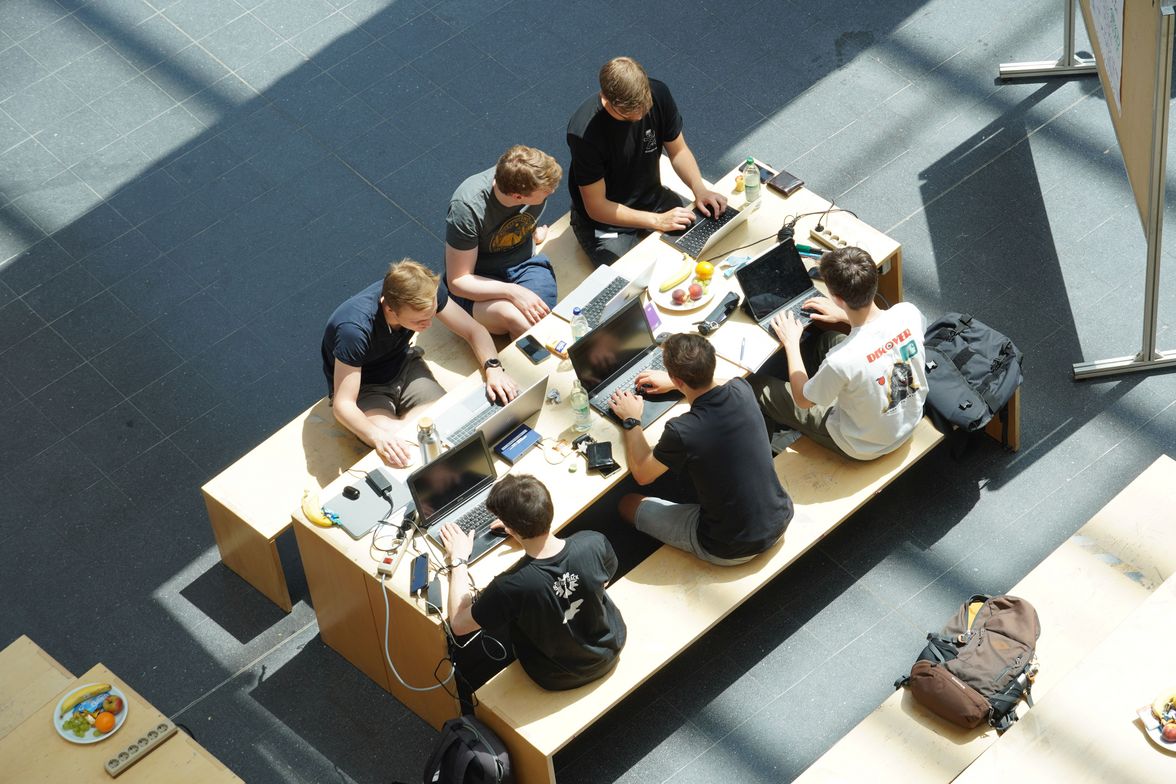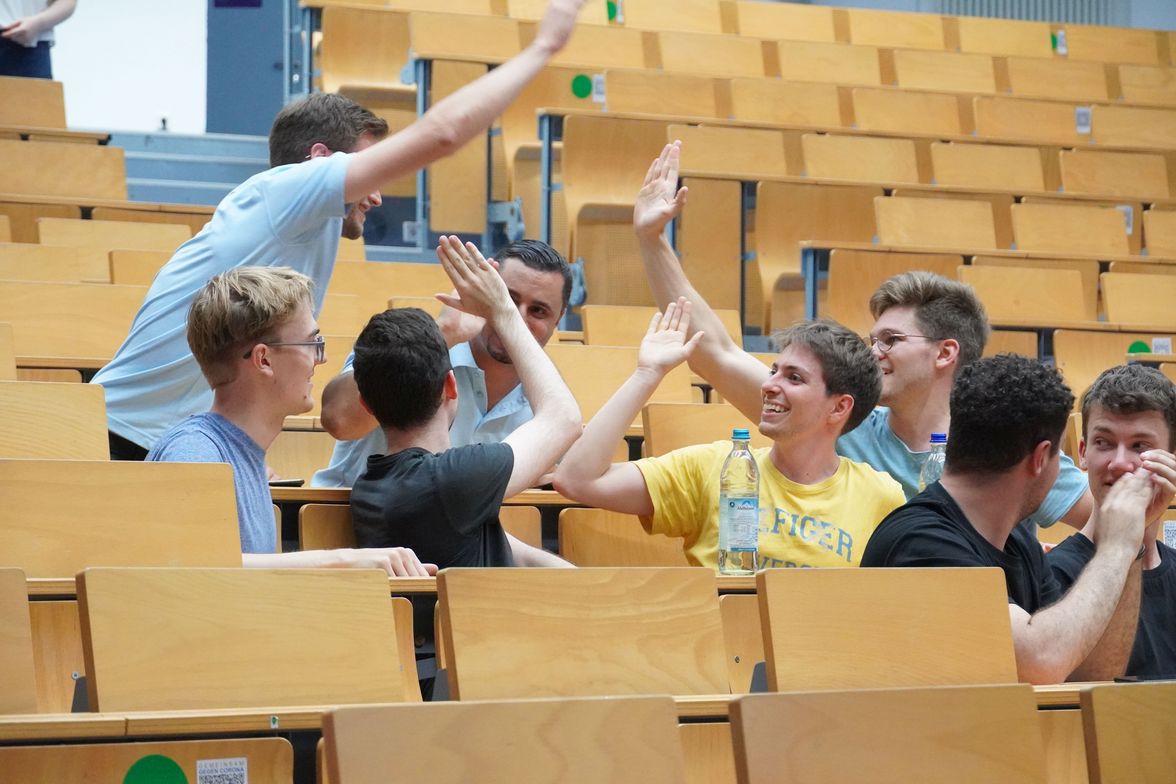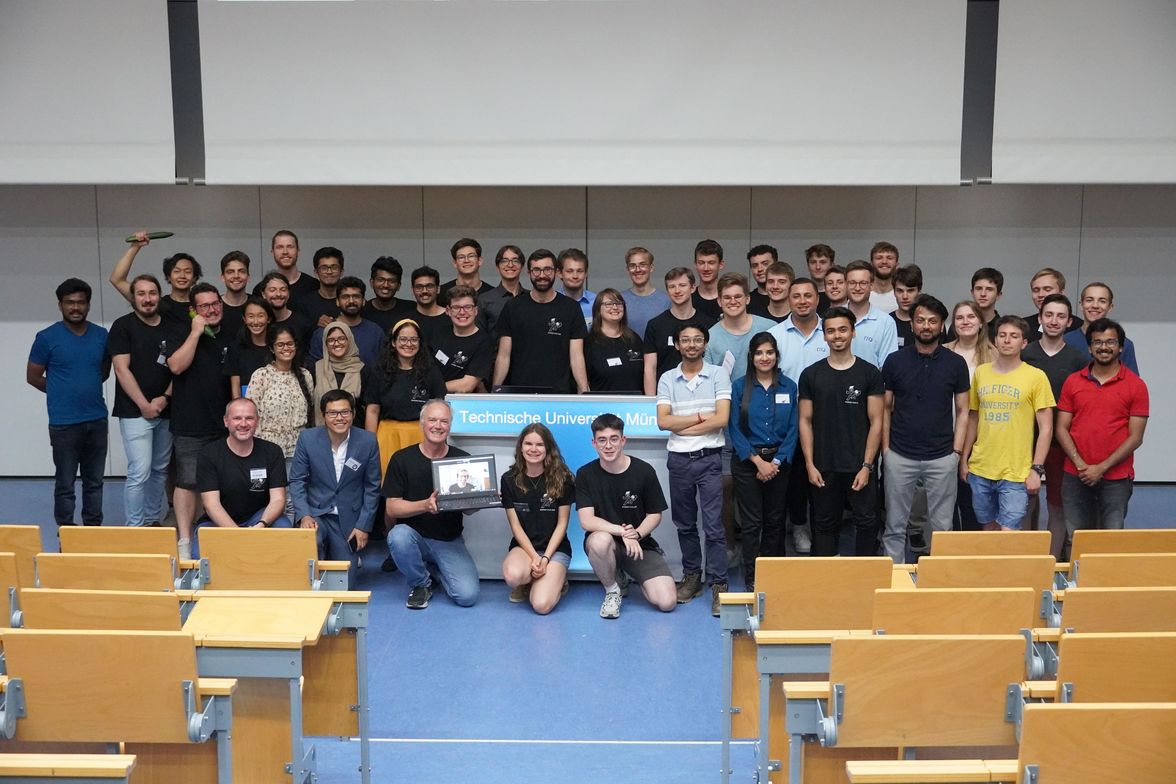TUM Science Hackathon 2022
Upgrade: Building A New Reality

This year's motto "Upgrade: Building A New Reality"
The motto of this year's TUM Science Hack was "Upgrade: Building A New Reality". It encapsulated many of the technological developments currently underway: be it through extended reality, or through novel communication pathways, artificial intelligence, new materials, or the bio-evolution in medicine. Supported by international collaboration, new technologies are enabling humanity to change its life so dramatically that we may soon find ourselves in an entirely new reality compared to today's standards.
Congratulations to our winning teams
- Team ams OSRAM with its project Building a new reality - Extend your vision into the Infra-red range. More reality is waiting here (view presentation)
- Team TUM Dermatologie and Deutsche Dermatologische Gesellschaft with its project Smart Cushion to prevent pressure ulcers (view presentation)
- Team ITQ with its project Smart Green Bio 2.0 (view presentation)
Jury
- Prof. Dr. Anna Keune (Learning Sciences and Educational Design Technologies, School of Social Sciences and Technology, TUM)
- Dipl.-Ing. Johannes Neubauer (Founder and Managing Director at Pixida)
- Stephan Wolf M. Sc. (Software Engineer at Quantco)
Participants
Students and Ph.D.-students from diverse fields of study from all universities of Munich were invited to participate in the #ScienceHack. We were very happy to welcome 57 participants this year. They displayed their creativity, passion and problem-solving skills towards solving challenges provided by the industrial partners and exceptional chairs of TUM.
Thank you!
Thanks to all participants, our top-level jury and our industrial and academic partners who made the TUM Science Hackathon possible! A very special thank you goes to all members of Taskforce CAP.
Industry Partners
CHALLENGE 1: Building a new reality – Extend your vision into the Infra-red range. More reality is waiting there.
Background
With a hyper spectral camera you can see colors outside of the visual spectrum
Challenge Details
- What would you do with this extended range of visualization?
- Where and how would you like to use it?
- Would it be beneficial to be able to find out more on product quality, food properties and other non-visible attributes of the world around you?
Background Knowledge You Bring To The Team
The students should know about spectroscopy, knowing the effects of material observed within infra-red light. So some physical understanding in optics or chemical examination methodology would be beneficial.
CHALLENGE 2: Future application use cases for AR (Augmented reality) smart glasses
Download the challenge description here.
Background Knowledge You Bring To The Team
The students need to utilize their engineering and user know-how to face the challenge. Knowledge of the “design thinking” method would be helpful but is not mandatory.
Introduction
STORM REPLY is the company in the Reply group specialized in the design and implementation of innovative Cloud-based solutions and services.
Through consolidated expertise and many years of experience in the creation and management of Infrastructure as a Service (IaaS), Software as a Service (SaaS), and Platform as a Service (PaaS) Cloud solutions, Storm Reply supports important companies in Europe and all over the world in the implementation of Cloud-based systems and applications.
STORM REPLY is Amazon Web Services Premier Consulting Partner since 2014, one of the best Amazon Partners in the world, and one of the few companies to have so many different competencies attested by AWS: Financial Services, Security, Machine Learning, SaaS, Data & Analytics, DevOps, Industrial Software, IoT, Migration, Oracle.
Challenge Details
Storm Reply turns mountains of their customer‘s data into actionable insights. Do you think you can do it better? Create cloud solutions on the AWS platform that outshine us in this medical data engineering challenge. To build the winning algorithm, engineer a system that outperforms ours - your project will be judged on the following criteria:
- algorithm performance (timings, accuracy)
- quality of code
- complexity of code
Turn data into value with us!
Required Tool Skills
- Interest in AWS
- SQL à Relational Databases
- Programming Skills (Python, JavaScript, Java, C++, or other object oriented language)
- Basic medical knowledge
Background Knowledge You Bring To The Team
- Basic knowledge in statistics
- Basic AWS Knowledge
- Presentation skills for final solution
SMART GREEN BIO 2.0
Motivation
In recent years, it has become increasingly clear that health and nutrition is playing an ever- greater role in the daily lives of many people. Never before have so many different diets been pursued as today, and food has been intensively studied. Not only the product itself, but also its origin as well as production is an important criterion in the product choice of consumers and must take more sustainability into account.
One approach to achieving this could be to make it possible to virtually experience product characteristics, particularly such as the origin, the harvesting process, and the lifetime of products in a wide variety of areas – be it in the vegetable aisle, at the weekly market, when eating in a restaurant, or at the farmer’s farm. For example, a QR-code on the respective product could also contribute to this. Another newly and High-Tec approach is to record the plant’s lifetime in a feasible SMART GREEN ITQ GARDEN.
Challenge details
- How could a concept look like?
- Who wants to check the origin of the food?
- When do customers want to check the origin of the food?
- How could a mobile SMART GREEN BIO app look like?
Tools You Will Work With
- AR Glasses (Hololens)
- VR Glasses
- AR or VR via SmartPhone-App
Background Knowledge You Bring To The Team
- IoT
- Web Development
- UI/UX-Design
- Smart Farming
- Bio Food Consumption
- Smart Green Concepts & Technology
- Marketing
- AI
- Big Data
Vision
'Building A New Reality' is only possible if we build on new ideas. Green architecture and construction are an essential strategy to address the shortage of resources. It is the path to go for a sustainable and healthy living environment. Plants are already the key component to make cities enjoyable - but they can do more. Integrating them as structural elements in buildings means integrating nature in our life. Let's convert buildings into living buildings.
The Challenge
Develop a vision how a digital twin of growing plants supports the vision of living buildings. Think about data driven architecture and construction for a successful deployment. Are historical data necessary or the collection of information in real time - just envision new ideas.
Support You Receive
Altair will provide first class development tools for data management, IoT, dashboarding, control design, engineering and much more. We will support you with our deep understanding of lightweight design, electric driveline optimization and data science.
Background Knowledge You Bring To The Team
- Architecture and Civil or Mechanical Engineering, Computational Science or Informatics
- Business Management, Marketing
- Team player, well organized - customer centric thinking
Background
The XR HUB Bavaria is an initiative to strengthen Bavaria as a media and business location, funded by the Bavarian State Ministry for Digital Affairs. We have developed the
XR Network, a platform to strengthen the XR community and promote active exchange, as well as the XR Spaces, a platform to connect self-created virtual 3D showrooms with each other and thus take a joint step towards the metaverse.
Vision
Our vision is a functionality that allows the automated generation of virtual 3D showrooms based on existing datasets from user profiles from the XR Network, as well as their integration into the XR Spaces.
Mission
You will develop a theoretical concept that describes concrete possibilities to automatically generate and fill virtual showrooms based on existing data from the user profiles of the XR Network, if possible, in the form of 3D elements. In addition to the description of current and future possible functionalities and algorithmic automation processes, as well as their added value from the user's point of view, concrete technical solution and implementation possibilities are also required. If possible, we also look forward to a first prototypical implementation on your part. We will provide a 3D model of a showroom and an exemplary dataset of an XR Network profile that you can use for the implementation.
Tools You Will Work With
- Mozilla Hubs
- A-Frame / Three.JS
- JavaScript
Background Knowledge You Bring To The Team
- 3D Development
- Web Development
Download original challenge description
TUM Partner
Smart Cushion to prevent pressure ulcers
Motivation
Besides COVID-19 there is another, lesser known, but arguably very important epidemic lurking in the shadows. The so-called silent epidemic refers to chronic, hard-to-heal skin wounds due to bed sores (decubitus). They are caused by prolonged pressure on bony parts of the body and disproportionately affect elderly, and chronically ill patients. If left untreated and unsupervised, they present a major risk for infections up to sepsis and death. An estimated 500.000 people suffer from this disease in Germany alone every year resulting in an economic damage of 1.0 - 2.0 billion EURO per year. Advanced-stage bed sores and other slow-healing wounds require continued, specialised treatment to provide optimal conditions for the healing process. Even so, they are extremely slow to heal and represent a major challenge in the management of elderly and chronically ill patients. One of the most important treatment and preventative principles is relieving pressure on exposed areas.
Current commercialized solution to help with the issue consist of a pneumatic system which sequentially inflates and deflates an array of air cushions embedded in the mattress to generate waves to prevent the concentrated pressure and improve blood circulation.
Objective
A smarter way could be the use of a distributed pressure sensory network, covering the entire area of the cushion to have a detailed pressure profile based on different physical activity or sleeping habits of the person. This leads to detection of more susceptible parts of the skin for wound development. Sensor’s data can be fed to the neural network for feature extraction and more detailed analysis.
The final goal is to realize a smart cushion connectable to smart phones that not only benefits from the current pneumatic actuating system, but also does the task in a smarter fashion.
Background Knowledge You Bring To The Team
- Material science - Textile engineering
- Electronic engineering
- Mechanical engineering
- Computer Science
- Medicine







